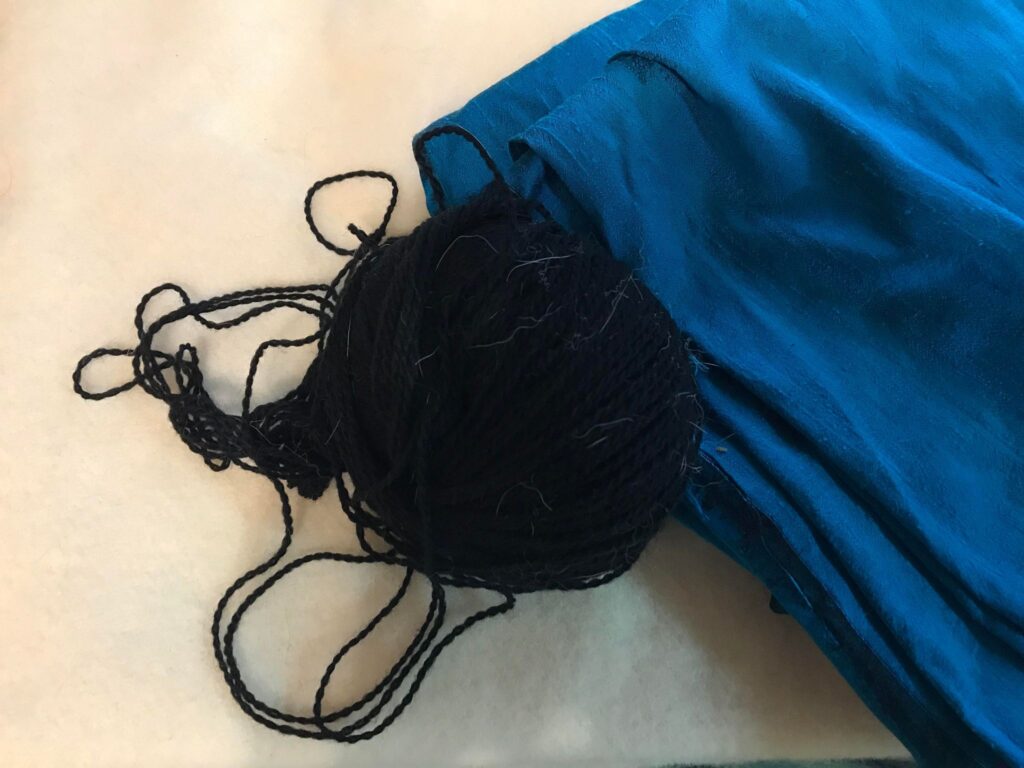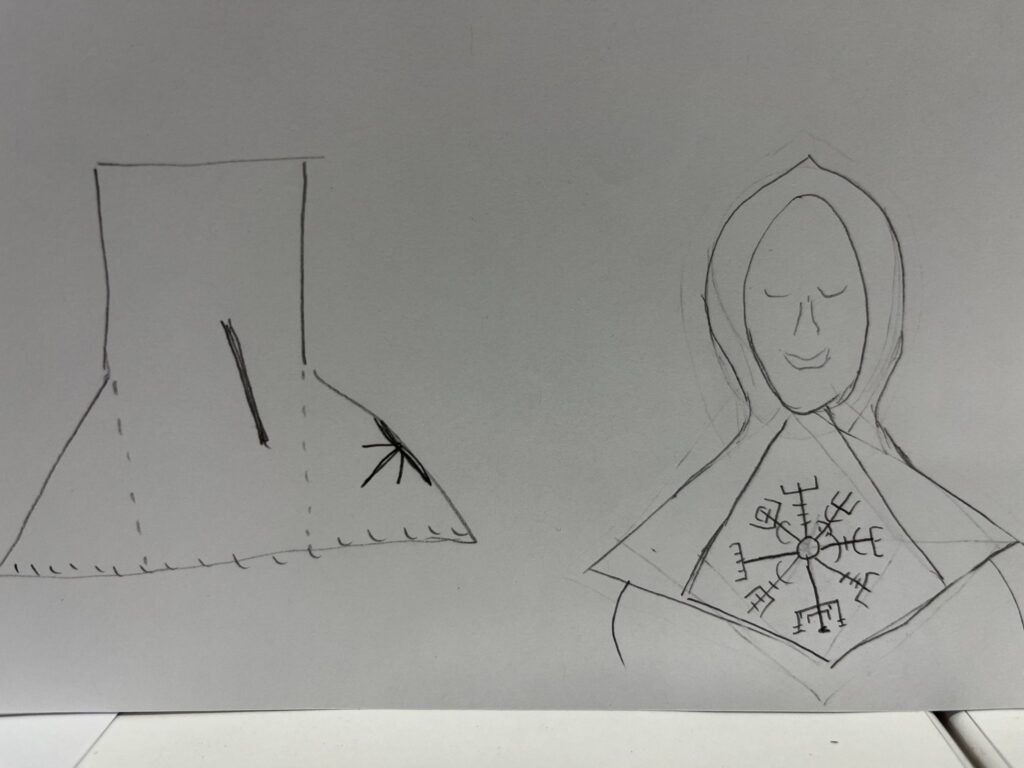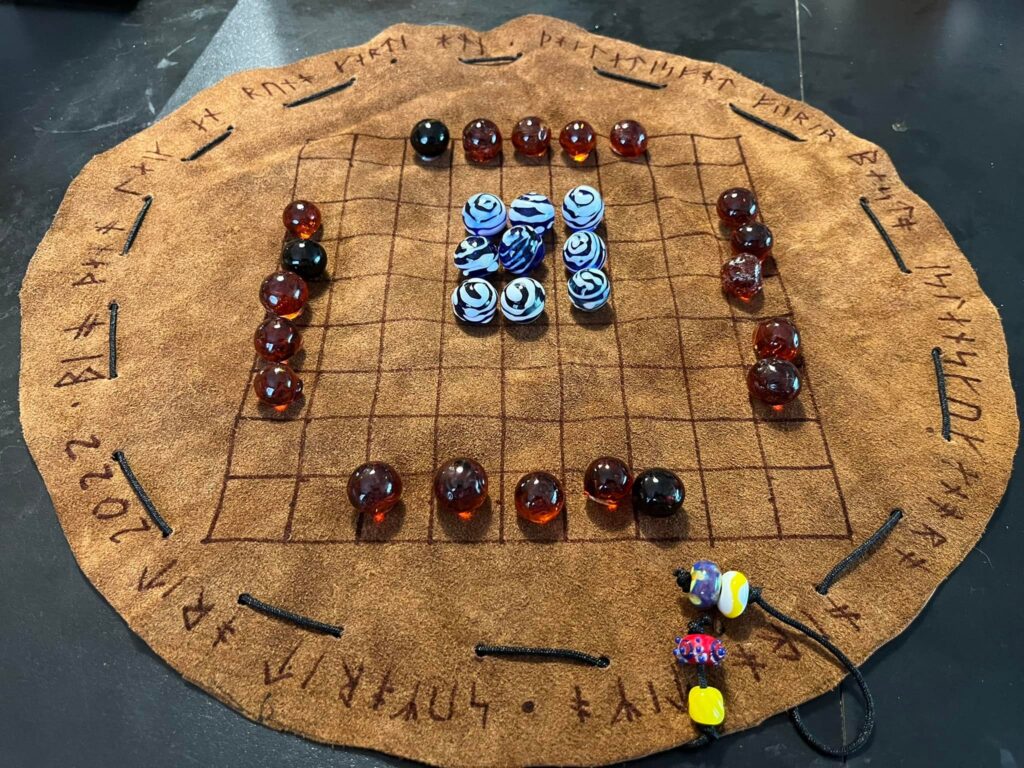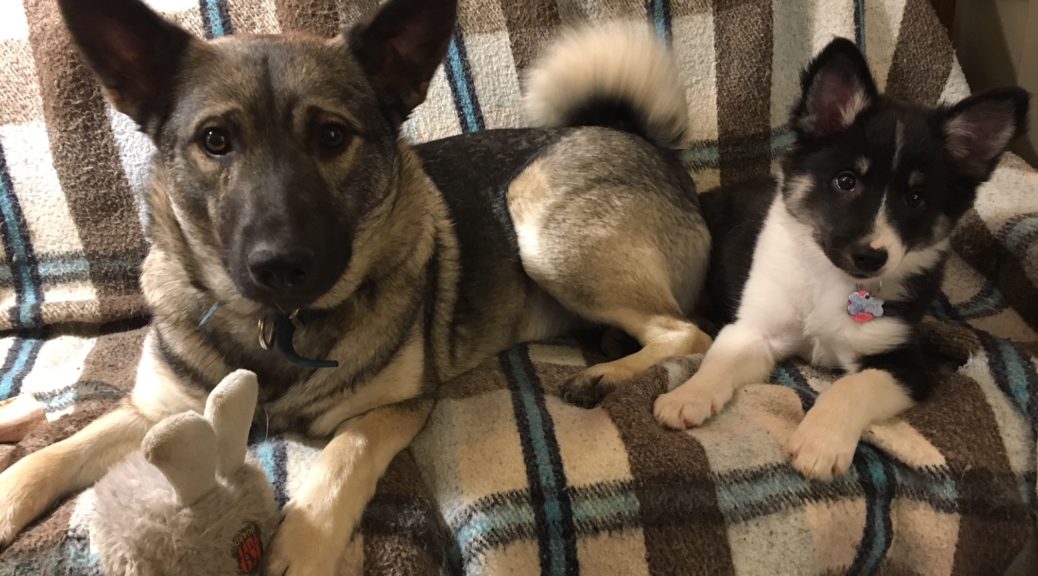This is a project that started because I wanted to find definitive proof that Icelandic Sheepdogs have existed in pretty much the same form since the Viking era. I’m still working on THAT particular part of it, but that has since spawned a number of offshoot projects, including research on other animals, as well as learning to speak/read/write Icelandic. (The latter was sparked by coming into a number of interesting pieces of research written in Icelandic at the same time). This article was referenced by this page on the ISAA website, and I went in search of it. I was unable to find a copy via inter-library loan within Canada, and in the end, I resorted to using the online help application on the website for the University of Iceland’s Library, and an extremely nice and helpful gentleman named Jóhann who works there scanned the article and sent it to me via email in PDF form. I then set about translating it using my weird little method, and then my friend Sara proofed my translation and made a few small edits to make the translation clearer. So here I present to you, my translation of Uppruni Íslenskra Húsdýra by Stefán Aðalsteinsson. If you would like to see the original text, with all of the references to his source material, I have that as well, and you can download it here: Uppruni Íslenskra húsdýra final. The spacing in this document is somewhat funny, as I have done it as a side by side comparison of the Icelandic and English, and I have tried to keep the paragraphs of each language next to each other. In some places, I have added translator’s notes for further clarification, and in these instances the English paragraph is much longer than the Iceland. I suspect some future projects will be obtaining some of his sources and translating those.
Origin of Icelandic domestic animals, by Stefán Aðalsteinsson
Premises
The origin of Icelandic domestic animals can give some indications as to where the people came from who built Iceland in the past. From the lay of the land and the weather, it is believed that the first settlers sought to build their livelihood to a significant extent on livestock and brought it to their country from their homeland.
It is possible to discover the origin of domestic animals by various methods. First we should consider the bones that have been found from the years the first settlers came in, both in Iceland and in the countries that the animals could be from.
Historical sources can indicate where our domestic animals might have come from. However, it should be noted that all stories from the settlement in Iceland and the early years of the country were written long after the settlement, and their direct validity is limited for this reason. However, descriptions of livestock from the time stories were first put down in writing can provide some information on how livestock came here, for example due to the relatively short amount of time from landing.
A comparison of the livestock foundations in modern Iceland and neighboring countries can also give evidence of the origin of Icelandic domestic animals. However, such a comparison must be done with caution because changes might have happened in livestock farms in Iceland and neighboring countries in the past eleven centuries.
In the neighboring countries, the breeding policy in the 18th and 19th centuries that grew up in a group of livestock communities, was to produce a uniform breed. This was called for to achieve a solid breed. For this reason, it is highly doubtful to use the external characteristics of livestock in modern times to judge the outer appearance of different livestock models because related livestock may have changed to different degrees of such a selection, and the distant related kinds have gotten similar in look and structure because of selective breeding in the same direction.
Icelandic farm animals may also have changed in the past decades and centuries from the way they were at the time of settlement. There are many attempts to import sheep and cattle to the country. It is also known that sheep, horses and cattle fell untouched in hard times in the early centuries. Likewise, it is known that in recent decades there have been major changes in sheep, cattle and horses in the past decades, as a result of targeted breeding.
The main way to avoid the effects of various types of comparison between livestock breeds is to choose for heritable traits that can not be judged by external appearance. Blood from the tract is often taken into account, and hereditary genes are found, such as blood type, egg whites and tissue groups.
The points outlined above need to be considered when attempting to draw a picture of the origins of Icelandic domestic animals.
Cattle
Extensive research has been conducted on the origins of Icelandic cattle. Information on cattle from ancient journals that may be helpful in tracing their origins is very scarce. However, referring to the colors of the bull Brandkrossa in Brandkrossa Þattur (this is the name of one of the Sagas – ed.) he drank milk in both winter and summer, but he was a pale pink color. The key is that the grip has a red base and dark cross sections in the areas that are reddish. Crossbones are called cattle that have a white color in the front that extends to the eyes and ears. When the white color returns to the eyes and back or over the ears, it is said that the grip is helmetlike (other color on the head than the rest of the body) or húfótt is another word for white colour on the head, helmet like.
Horned cattle were most common in the past, as the horns made cattle valuable. Hornless cattle have been in Iceland since ancient times. Pieces of skull from hornless cattle were found in a bone collection, which came from the excavation of a house at Aðalbóli in Hrafnkelsdalur valley. Skulls of hornless cattle were also found in the skeletal remains excavated in Stóraborg under Eyjafjöll. (Translator’s note: Stóruborg was an old manor town near the volcano Eyjafjöll in southwestern Iceland. It existed there from approximately the year 1000 until 1840, when it was moved 640m to protect it from the sea. Ref: Sunnlenskar byggðir IV). Also, skulls of hornless cattle have also been discovered by excavation in the settlements of the ancient Greenlanders. Both indicate that hornless cattle were taken to Iceland during the settlement. In the 16th century, beautiful horned Icelandic cattle. However, there were a few hornless bulls in Iceland. At the beginning of the 19th century, cows in Iceland were mostly hornless, but there were many horned cows. This suggests that men had begun to choose intentionally for hornless calves beyond the 16th century. In the early 20th century, cattle in Iceland were very diverse in color and exterior appearance.
A few attempts were made to import Danish cattle to Iceland in the 19th century, but it was said that they had a minor effect on the Icelandic cow.
Two studies have been conducted on blood groups and egg white models in Icelandic cattle. In the previous study it became apparent that Icelandic cattle were closely related to old Norwegian landraces, ie. Þelamerkur, Dala and Þrændakúm. In this study, it was further noted that Icelandic cows completely lacked blood type genes that characterize Jersey cows. The speculation that Icelandic cows are to some extent derived from Jersey cattle is unsubstanstiated.
The latter study found that Icelandic cattle were closer to Guernsey cattle, when compared to other European types, than the Norwegian ones. However, the genetic distance of Icelandic cow from Guernsey cattle was more than twice as much as the distance from Norwegian cows to Guernsey cattle.
Kinship with Guernsey cattle has not been observed in all studies. In the previous study of blood counts of Icelandic cattle, Icelandic cows were less related to Jersey cattle and Guernsey cattle than the other coworkers compared to those studies.
A scholarly assessment of Icelandic cattle’s relation to cattle in other countries stated that the relationship with the old Norwegian cattle was very close. If it were assumed that Icelandic cows were randomized samples from Norwegian cows during the settlements, the difference between a thorough assessment of Icelandic cattle’s relations with cattle from other countries was that the relationship with the old Norwegian cow was very close. If it were assumed that Icelandic cows were randomized samples from Norwegian cows during the settlements, the difference in modernity was no greater than that which could only be caused by settlement until 20th century.
Horses
Icelandic horses are different from other horses, as is best seen by how much attention Icelandic horses have attracted overseas in this century.
Ancient stories tell you about famous horses. A female horse named Fluga, who came with a ship that landed at Kolbeinsárós (translator: a trading post at the mouth of the rivers Kolka and Hjaltadalsá), was the fastest of all horses. Hauknefur in Gotland gave Gull-Þóri Kinnskæ, a dark red horse who was a gauskur (Swedish) runner and was fed in winter and summer on grain. Freyfaxi Hrafnkels Freysgoða was pinkish in color according to the most widely used script of Hrafnkel’s story. In older versions, he was said to be brown. He was the cause of great events.
Studies on Icelandic horse bones from pagan graves indicate that Icelandic horses are very similar to Norwegian horses as they were before Iceland’s settlement. They also resemble horses from 6 to 8th century in Beckum in Germany. However, Icelandic horses have been smaller at the time of settlements than the German and Norwegian horses that they were compared to. Horse bones have also been found in Greenland that are very similar to ancient bones from Icelandic horses.
Icelandic horses have been known for a long time for their light-footed gait. It has been mentioned that horses that could both tölt and skeið (Translator: the tölt and skeið are both gaits that the Icelandic horse has – the Icelandic horse has 5 gaits, instead of the 4 that most horses have) have been eradicated in mainland Europe by using horses for wagons to a greater extent than before. Trotting worked better.
The Nordland horse from Norway is considered the forefather of the Icelandic horse. Is then judged by external appearance, facial appearance and character. Blood group research, however, indicates that the Icelandic horse is more related to the Shetland horse, than the Nordland horse and the Fjord horse in Norway. It is not surprising because Hjaltland (Shetland) was a Norwegian territory for hundreds of years, so it was unlikely that men had taken horses from Norway when Norwegians started settling there. It is surprising, however, that Icelandic horses are not very related to the Norwegian Fjord horse. The most reasonable explanation for this is that the Fjord horse has changed significantly since the settlement.
Horses were cars on land in the past. As transportation on land grew easier, the movement of horses between countries grew ever greater. Horses, however, have barely been transported between countries during the peace period. Horse exchange and horse buying were an easier solution and must have been known as now. In the wars horses played a different role. Vikings who attacked England from mainland in 892 had horses aboard their ships. Ólafur Tryggvason and Sveinn Tjúguskegg attacked London in September 994, but were driven out and suffered great losses. Then their army returned on horseback and went far into the land and did a lot of damage (bál og brand is a saying in Iceland, meaning a lot of damage)
There has been no reason to import horses from other countries to Hjaltland and Iceland later in the settlement era and horses had become commonplace.
Sheep
Sheep have been in Iceland since the settlement, but no sources are available regarding where they came from. The Icelandic sheep is from Northern European short-tailed sheep. They are in Iceland, the Faroe Islands, Shetland and Orkney, Norway, Sweden and Finland. The sheep of this kind have a short tail or “dindil” (the word we use for a short tail on the sheep) and the wool of this sheep is usually found in two forms, the rough tog and fine thel. In Finland, Sweden and Norway, it is common for both sexes to be unhorned, but also for both sexes to be horned. Four horned sheep occur in Sweden and are considered to occur in Norway but is very rare. In the Faroe Islands, Hjaltland and Orkney, rams are usually horned and females hornless. It occurs in free range sheeps on the island of Soay (Sauðey) in Scotland and in the UK’s long tailed breed, and more in sheep breeds in southern part of the continent, such as merino in Spain.
In Icelandic sheep, both sexes can be horned or the female can be hornless (kollóttar) or hnýflóttar (a horn that stands straight up like a finger and is usually short on females), and the males can be hornless (kollóttir), örðóttir (a horn that can be felt under the skin but has not broken through, or has broken through but is very short), hnýflóttir (a horn that stands straight up like a finger and is usually short) or sívalhyrndir (when the horns are round, like the typical ram pictures).
It is not common that the rams are horned and the ewes are hornless. This alone is in fact sufficient proof that Icelandic sheep come from the Nordic region. When color is taken into account, it is still possible to narrow the area. The colors of Golsótt and Botnótt are found in the Norwegian short tailed sheep and on Icelandic sheep. (Translator’s note: Golsótt is when the underfleece is white and the longer hair is black/grey, but the stomach is usually white or black, and Botnótt is when the stomach to the butt is white and rest of the body is a darker colour, are the names for special fleece colours in Icelandic sheep). In both genders, the Icelandic model is of gray and in both genders there is a black and dark red color. Norway has more solidarity with Icelandic sheep in colours and types of horns than any other sheep breed in the Nordic region. In addition, there is a good match between these sheep breeds in hereditary hemoglobin and blood potassium. Accordingly, Icelandic sheep come from Norway.
Goats, pigs and dogs
Goats came here during settlement. They are mentioned in ancient stories, and many place names are associated with goats. (örnefni can be nickname for places, and also nickname for people, but in this instance they are referring to place names). Nothing can be said concretely about the origin of Icelandic goats but going by the colors and horns they resemble Norwegian goats.
Pigs were brought to Iceland during settlement. They are mentioned in stories and many place names are associated with them. Pigs still existed in Iceland in the latter part of the 16th century, but died out in the 17th century.
Two types of dogs seem to have been brought to the country during settlement. One of them is of an average size, but the other is much larger. Bones of the larger species have been discovered in Greenland, and have been similar to Irish Wolfhounds. It is tempting to associate that finding with the story of Sámi that Olaf was given in Ireland, and later he should have given Gunnari on Hlíðarenda.
Hunting dogs that were much larger than other dogs were in Iceland in the 16th and 18th centuries but appear to have died out late in the 18th century. They may have all been put down in the Mist Hardship. (Translator’s Note: a famine which occurred after the eruption of the volcano Laki in 1783/84 which lasted for 8 months and killed many people and animals)
Blood tests that have been carried out on the Icelandic Sheepdog, which have been bred here in recent decades, indicate that they originate from the Nordic countries.
Cats and mice
Cats have been brought to Iceland in the early centuries, ie. during settlement. The cat belly was a commodity of ancient times, and the belly of a male cat was worth the equivalent of three autumn lambskins. Studies on the color genes in cats in Iceland and neighboring countries show that the Icelandic cat is closely related to cats in Sweden and in the Shetland Islands, but distant related to cats in Ireland and in South England.
Mice in Iceland are field mice. They enter houses during the winter, but move into the pasture during the summer. Characteristics of mouse skulls indicate that field mice had been brought to Iceland from Norway, from which mice would also have been sent to Shetland and the South Tyrol. Blood type studies did not give a clear answer to where the Icelandic mice had come from.
Studies on parasites on the Icelandic mouse have revealed that they are a species of flea that is found only in continental Europe. Mice in the British Isles have another type of this flea. The differences show that the Icelandic field mouse does not come from the British Isles, and the skull leads strongly to the mice coming from Norway.
A further article has been drawn up for the origin of Icelandic domestic animals in other areas and is referred to.




 Yesterday I spent my whole lunch break out on the back lawn of my workplace, working on sorting and separating the drawstring bag full of fleece I have washed up. I took advantage of the natural light to take some pictures while I was working, as well, so I can show you better the difference between the tog and the þel.
Yesterday I spent my whole lunch break out on the back lawn of my workplace, working on sorting and separating the drawstring bag full of fleece I have washed up. I took advantage of the natural light to take some pictures while I was working, as well, so I can show you better the difference between the tog and the þel.


 And finally, a picture of the three piles together. On the left top, the unseparated fleece. On the top right, the þel after the tog is pulled out, and in the middle bottom is the pile of just tog. I’m going to save the tog for another project in the future – it might be suitable for spinning up a little thicker and then naalbinding into mittens, since the tog will make for very sturdy items, and a bit more waterproof too. We’ll see how much of it I have after I finish separating all 3 fleeces that I have.
And finally, a picture of the three piles together. On the left top, the unseparated fleece. On the top right, the þel after the tog is pulled out, and in the middle bottom is the pile of just tog. I’m going to save the tog for another project in the future – it might be suitable for spinning up a little thicker and then naalbinding into mittens, since the tog will make for very sturdy items, and a bit more waterproof too. We’ll see how much of it I have after I finish separating all 3 fleeces that I have.